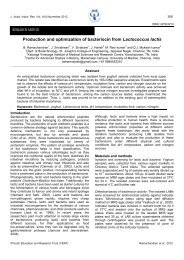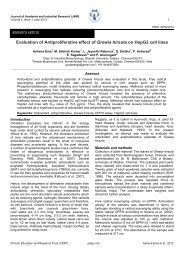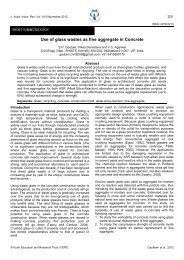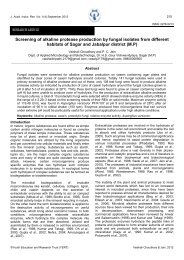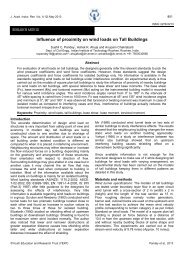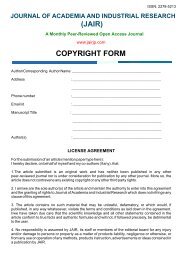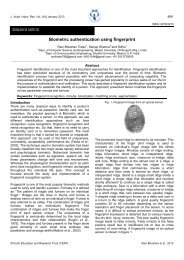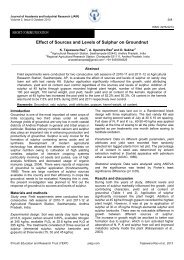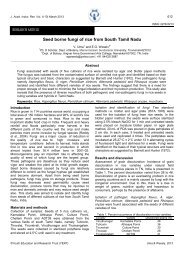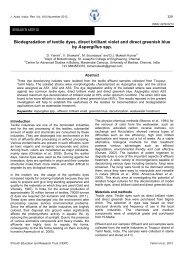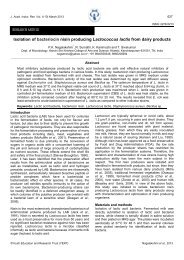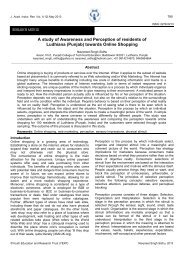Screening of Urinary Tract Infection causing bacteria and their ...
Screening of Urinary Tract Infection causing bacteria and their ...
Screening of Urinary Tract Infection causing bacteria and their ...
Create successful ePaper yourself
Turn your PDF publications into a flip-book with our unique Google optimized e-Paper software.
Journal <strong>of</strong> Academia <strong>and</strong> Industrial Research (JAIR)Volume 2, Issue 1 June 2013 61Table 5. Virulence factors <strong>of</strong> E.coli isolates.Strain SexAgeCell surfaceβ –lactamase(years)hydrophobicityE-1 F 10 Positive 83.49E-14 F 27 Positive 75.23E-16 F 21 Positive 80.76E-17 F 15 Positive 77.31E-18 M 45 Positive 86.40E-21 M 22 Positive 82.65E-27 F 31 Positive 87.5E-30 F 22 Positive 81.18E-40 M 35 Positive 75.29E-41 F 34 Positive 79.31E-42 M 17 Positive 81.05E-48 M 59 Positive 85.71E-58 F 30 Positive 86.66E-59 F 27 Positive 81.48E-60 M 19 Positive 84.14E-61 M 37 Positive 85.56E-65 F 10 Positive 88.42E-72 M 53 Positive 86.95E-80 F 20 Positive 84.21E-85 M 25 Positive 82.29E-86 M 31 Positive 82.72E-87 F 66 Positive 76.85E-97 F 49 Positive 81.65E-98 F 52 Positive 80.35E-99 F 37 Positive 88.54Thus, the highest incidence <strong>of</strong> virulence factors, recordedby the E. coli strains became more resistance to severalantibiotics because they help the organism to overcomehost defenses <strong>and</strong> colonize or invade the urinary tract.Virulence factors are very <strong>of</strong>ten responsible for <strong>causing</strong>disease in the host because they are <strong>of</strong>ten responsiblefor converting non-pathogenic <strong>bacteria</strong> into dangerouspathogens.ConclusionPrevalence rate <strong>of</strong> E. coli was found to be the mostcommonest organism for UTI in all age groups <strong>and</strong>showed resistance to commonly used antibioticsespecially, 100% resistant to cefpodoxime <strong>and</strong>novobiocin. The test isolates <strong>of</strong> E. coli tested positive inβ-lactamase, slime production <strong>and</strong> higher percentage incell surface hydrophobicity showed high antibioticresistance. But the prevalence <strong>of</strong> antimicrobial resistancecan vary according to geographical <strong>and</strong> regional location.Hence, finally we recommend the selection <strong>of</strong> antibioticshould be based on knowledge <strong>of</strong> local prevalence <strong>and</strong>we suggest to mitigate the problem <strong>of</strong> antibioticresistance is development <strong>of</strong> new antimicrobial drugs forUTIs.References1. Alon, U., Davidai, G., Berant, M. <strong>and</strong> Merzbach, D. 1987.Five-years survey <strong>of</strong> changing patterns <strong>of</strong> susceptibility <strong>of</strong><strong>bacteria</strong>l uropathogens to trimethoprim sulfamethoxazole<strong>and</strong> other antimicrobial agents. Antimicrob. AgentsChemother. 31: 126-128.2. Banciu, N. 2005. Preventia infectiei si higiena in mediulspitalicesc. Editura Viata Medicala Romaneasca, Bucuresti.3. Barret, S.P., Savage, M.A., Rebec, M.P., Guyot, A.,Andrews, N. <strong>and</strong> Shrimpton, S.B. 1999. Antibiotic sensitivity<strong>of</strong> <strong>bacteria</strong> associated with community-acquired urinarytract infection in Britain. J. Antimicrob. Chemother. 44: 359-365.4. Charles Bryan. 2011. Infectious disease, chapter seven,<strong>Urinary</strong> tract infections from Infectious Disease Section <strong>of</strong>Microbiology <strong>and</strong> Immunology On-line. University <strong>of</strong> SouthCarolina.5. Cheesbrough, M. 2004. Morphology <strong>and</strong> characterization <strong>of</strong>E. coli <strong>and</strong> S. aureus. District laboratory practice in tropicalcountries part II. Cambridge University. pp.157-179.6. Cowan, S.T. <strong>and</strong> Steel, K.J. 1985. Manual for theidentification <strong>of</strong> medical <strong>bacteria</strong>. 4 th edn. CambridgeUniversity Press. London. p.217.7. Czaja, C.A. <strong>and</strong> Hooton, T.M. 2006. Update acuteuncomplicated urinary tract infection in women. Postgrad.Med. 119: 39-45.8. Fawole, M.O. <strong>and</strong> Oso, B.A. 1988. Laboratory manual formicrobiology, 1 st edn. Spectrum Book Ltd., Ibadan. pp.22-45.9. Florian, M.E., Wagenlehner, K.G. <strong>and</strong> Naber, S. 2006.Treatment <strong>of</strong> <strong>bacteria</strong>l urinary tract infections: Presence <strong>and</strong>future. Euro. Assoc. Urol. 49: 235-244.10. Foxman, B., Barlow, R., D’Arcy, H., Gillespie, B. <strong>and</strong> Sobel,J.D. 2000. Self reported incidence <strong>of</strong> urinary tract infection<strong>and</strong> associated costs. Ann. Epidemiol. 10: 509-15.11. Freeman, D.J., Falkiner, F.R. <strong>and</strong> Keane, C.T. 1989. Newmethod for detecting slime production by coagulasenegative Staphylococci. J. Clin. Pathol. 42: 872-874.12. Gruneberg, R.N. 1994. Changes in urinary pathogens <strong>and</strong><strong>their</strong> antibiotic sensitivities, 1971-1992. J. Antimicrob.Chemother. 33(A): 1-8.13. Gupta, K., Scholes, D. <strong>and</strong> Stamm, W.E. 1999. Increasingprevalence <strong>of</strong> antimicrobial resistance among uropathogens<strong>causing</strong> acute uncomplicated cystitis in women. JAMA. 281:736-738.SexMaleFemaleSlimeproducersTable 6. Slime activity <strong>of</strong> E. coli isolates according to sex <strong>and</strong> age groups.Age group (years)0-10 11-20 21-30 31-40 41-50 Above 50Negative - - - 1 - -Weak - - - 1 - -Moderate - 1 2 1 - 2Strong - 1 - - 1 -Negative - - 1 - - -Weak 1 1 - - - -Moderate 1 1 - 3 1 -Strong - - 4 - - 2TotalNo. <strong>of</strong>positives914% <strong>of</strong>occurrence92©Youth Education <strong>and</strong> Research Trust (YERT) jairjp.com Sudha et al., 2013



